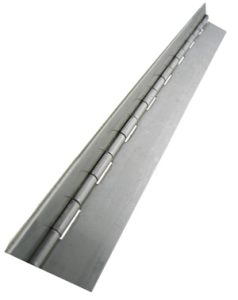
Not all hinges feature a bare-metal surface. Whether a hinge is made of high-carbon steel, stainless steel, brass or aluminum, it may have an outer layer of zinc. Electrogalvanized hinges and hot-dipped hinges, for instance, both feature a zinc layer. It acts as a protective barrier, shielding the underlying material from oxidative stress and damage. So, what’s the difference between galvanized and hot-dipped hinges?
What Are Electrogalvanized Hinges?
Electrogalvanized hinges are characterized by an electroplating process that’s used to apply a layer of zinc. Known as electrogalvanization, it’s designed to protect hinges from corrosion.
During the electroplating process, hinges are submerged in an electrolytic solution. An electric current is then applied to the solution. As the current passes through the solution, it will deposit zinc ions on the hinge’s surface. The end result is a newly formed zinc coating.
What Are Hot-Dipped Hinges?
Hot-dipped hinges are characterized by a heat-based finishing process that’s used to apply a layer of zinc. They are known as “hot-dipped hinges” because they are bathed or dipped in molten zinc. The raw zinc is initially heated to a temperature of about 840 degrees Fahrenheit. Once liquified, hinges are dipped in the molten zinc. As the molten zinc cools, it creates a hardened outer shell.
Differences Between Electrogalvanized and Hot-Dipped Hinges
While they both feature an outer layer of zinc, electrogalvanized and hot-dipped hinges aren’t the same. They involve different methods. Electrogalvanized hinges are submerged in an electrolytic solution that’s exposed to an electrical current. Hot-dipped hinges, on the other hand, are dipped in molten zinc.
Electrogalvanized hinges typically feature a thinner layer of zinc than their hot-dipped counterparts. The layer of zinc is about 5 to 30 microns thick, whereas hot-dipped hinges have a layer of zinc that’s about 45 to 100 microns thick.
Electrogalvanized and hot-dipped hinges have different finishes. Electrogalvanized hinges typically have a smooth and shiny finish. Hot-dipped hinges, on the other hand, typically have a rough, matte finish.
Another difference is the cost. While prices vary, electrogalvanized hinges usually cost less than hot-dipped hinges. Electrogalvanization is a faster and more efficient process than hot-dipping, resulting in a lower price for electrogalvanized hinges.
In Conclusion
For outdoor usage, you may want to choose electrogalvanized or hot-dipped hinges. They both feature a protective layer of zinc to discourage rust and corrosion. Electrogalvanized hinges and hot-dipped hinges simply involve different methods to apply the layer of zinc.
